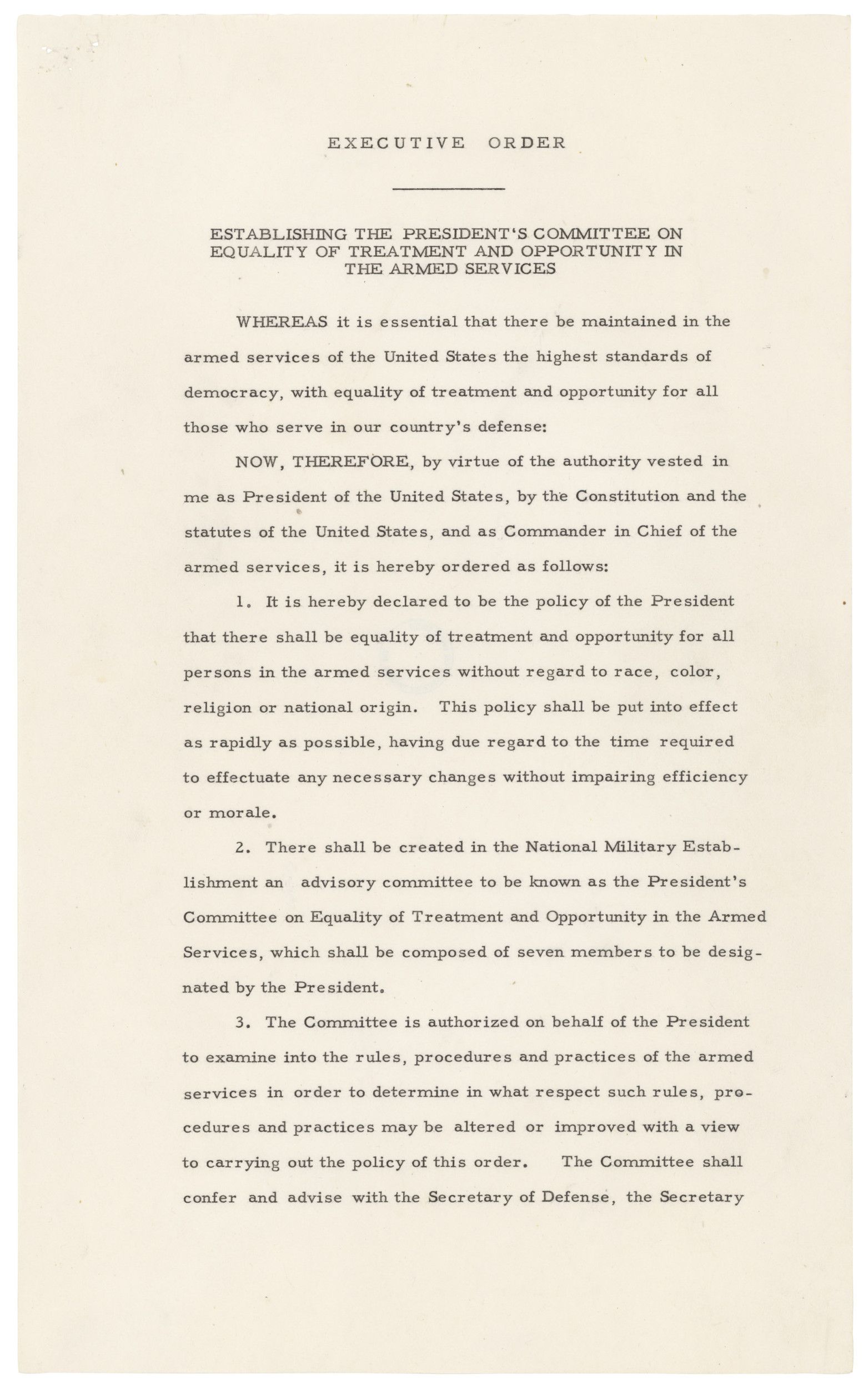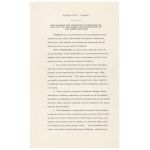Executive Order 9981 to Desegregate the Armed Forces
7/26/1948
Add to Favorites:
Add all page(s) of this document to activity:

Add only page 1 to activity:
Add only page 2 to activity:
With this executive order, President Harry S. Truman banned the segregation of the Armed Forces.
The order also established the President's Committee on Equality of Treatment and Opportunity in the Armed Services. It recommended revisions to military regulations in order to implement the government policy of equal treatment and opportunity for all members of the armed forces, regardless of race, color, religion or national original. The committee, chaired by Charles Fahy, was terminated upon submission of its final report, entitled Freedom to Serve, on May 22, 1950.
Back in 1940, African-Americans made up almost 10 percent of the total U.S. population (12.6 million people out of a total population of 131 million). During World War II, the Army became the nation's largest minority employer. Of the 2.5 million African-Americas males who registered for the draft through December 31, 1945, more than one million were inducted into the armed forces. Along with thousands of Black women, these inductees served in all branches of service and in all theaters of operation during World War II.
During WWII, President Roosevelt had responded to complaints about discrimination at home against African Americans by issuing Executive Order 8802 in June 1941, directing that Black Americans be accepted into job-training programs in defense plants, forbidding discrimination by defense contractors, and establishing a Fair Employment Practices Commission (FEPC).
After the war, President Harry Truman, Roosevelt's successor, faced a multitude of problems and allowed Congress to terminate the FEPC. However, in December 1946, Truman appointed a distinguished panel to serve as the President's Commission on Civil Rights, which recommended "more adequate means and procedures for the protection of the civil rights of the people of the United States." When the commission issued its report, "To Secure These Rights," in October 1947, among its proposals were anti-lynching and anti-poll tax laws, a permanent FEPC, and strengthening the civil rights division of the Department of Justice.
In February 1948, President Truman called on Congress to enact all of these recommendations. When Southern Senators immediately threatened a filibuster, Truman moved ahead on civil rights by using his executive powers. Among other things, Truman bolstered the civil rights division, appointed the first African-American judge to the Federal bench, named several other African-Americans to high-ranking administration positions, and on July 26, 1948, he issued an executive order abolishing segregation in the armed forces and ordering full integration of all branches.
Executive Order 9981 stated that "there shall be equality of treatment and opportunity for all persons in the armed forces without regard to race, color, religion, or national origin." The advisory committee examined the rules, practices, and procedures of the armed services and recommend ways to make desegregation a reality. There was considerable resistance to the executive order from the military, but by the end of the Korean conflict, almost all the military was integrated.
The order also established the President's Committee on Equality of Treatment and Opportunity in the Armed Services. It recommended revisions to military regulations in order to implement the government policy of equal treatment and opportunity for all members of the armed forces, regardless of race, color, religion or national original. The committee, chaired by Charles Fahy, was terminated upon submission of its final report, entitled Freedom to Serve, on May 22, 1950.
Back in 1940, African-Americans made up almost 10 percent of the total U.S. population (12.6 million people out of a total population of 131 million). During World War II, the Army became the nation's largest minority employer. Of the 2.5 million African-Americas males who registered for the draft through December 31, 1945, more than one million were inducted into the armed forces. Along with thousands of Black women, these inductees served in all branches of service and in all theaters of operation during World War II.
During WWII, President Roosevelt had responded to complaints about discrimination at home against African Americans by issuing Executive Order 8802 in June 1941, directing that Black Americans be accepted into job-training programs in defense plants, forbidding discrimination by defense contractors, and establishing a Fair Employment Practices Commission (FEPC).
After the war, President Harry Truman, Roosevelt's successor, faced a multitude of problems and allowed Congress to terminate the FEPC. However, in December 1946, Truman appointed a distinguished panel to serve as the President's Commission on Civil Rights, which recommended "more adequate means and procedures for the protection of the civil rights of the people of the United States." When the commission issued its report, "To Secure These Rights," in October 1947, among its proposals were anti-lynching and anti-poll tax laws, a permanent FEPC, and strengthening the civil rights division of the Department of Justice.
In February 1948, President Truman called on Congress to enact all of these recommendations. When Southern Senators immediately threatened a filibuster, Truman moved ahead on civil rights by using his executive powers. Among other things, Truman bolstered the civil rights division, appointed the first African-American judge to the Federal bench, named several other African-Americans to high-ranking administration positions, and on July 26, 1948, he issued an executive order abolishing segregation in the armed forces and ordering full integration of all branches.
Executive Order 9981 stated that "there shall be equality of treatment and opportunity for all persons in the armed forces without regard to race, color, religion, or national origin." The advisory committee examined the rules, practices, and procedures of the armed services and recommend ways to make desegregation a reality. There was considerable resistance to the executive order from the military, but by the end of the Korean conflict, almost all the military was integrated.
Transcript
Establishing the President's Committee on Equality of Treatment and Opportunity In the Armed Forces.WHEREAS it is essential that there be maintained in the armed services of the United States the highest standards of democracy, with equality of treatment and opportunity for all those who serve in our country's defense:
NOW THEREFORE, by virtue of the authority vested in me as President of the United States, by the Constitution and the statutes of the United States, and as Commander in Chief of the armed services, it is hereby ordered as follows:
1. It is hereby declared to be the policy of the President that there shall be equality of treatment and opportunity for all persons in the armed services without regard to race, color, religion or national origin. This policy shall be put into effect as rapidly as possible, having due regard to the time required to effectuate any necessary changes without impairing efficiency or morale.
2. There shall be created in the National Military Establishment an advisory committee to be known as the President's Committee on Equality of Treatment and Opportunity in the Armed Services, which shall be composed of seven members to be designated by the President.
3. The Committee is authorized on behalf of the President to examine into the rules, procedures and practices of the Armed Services in order to determine in what respect such rules, procedures and practices may be altered or improved with a view to carrying out the policy of this order. The Committee shall confer and advise the Secretary of Defense, the Secretary
of the Army, the Secretary of the Navy, and the Secretary of the Air Force, and shall make such recommendations to the President and to said Secretaries as in the judgment of the Committee will effectuate the policy hereof.
4. All executive departments and agencies of the Federal Government are authorized and directed to cooperate with the Committee in its work, and to furnish the Committee such information or the services of such persons as the Committee may require in the performance of its duties.
5. When requested by the Committee to do so, persons in the armed services or in any of the executive departments and agencies of the Federal Governemt shall testify before the Committee and shall make available for use of the Committee such documents and other information as the Committee may require.
6. The Committee shall continue to exist until such time as the President shall terminate its existence by Executive order.
Harry Truman
The White House
July 26, 1948
This primary source comes from the General Records of the United States Government.
National Archives Identifier: 300009
Full Citation: Executive Order 9981 Dated July 26, 1948, in which President Harry S Truman Bans the Segregation of the Armed Forces; 7/26/1948; Executive Orders, 1862 - 2011; General Records of the United States Government, Record Group 11; National Archives Building, Washington, DC. [Online Version, https://docsteach.org/documents/document/executive-order-9981, April 26, 2024]Activities that use this document
- Integration of the U.S. Armed Forces
Created by the National Archives Education Team
Rights: Public Domain, Free of Known Copyright Restrictions. Learn more on our privacy and legal page.


